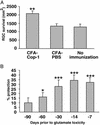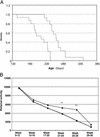Therapeutic vaccine for acute and chronic motor neuron diseases: implications for amyotrophic lateral sclerosis
- PMID: 12668759
- PMCID: PMC153634
- DOI: 10.1073/pnas.0530191100
Therapeutic vaccine for acute and chronic motor neuron diseases: implications for amyotrophic lateral sclerosis
Abstract
Therapeutic vaccination with Copaxone (glatiramer acetate, Cop-1) protects motor neurons against acute and chronic degenerative conditions. In acute degeneration after facial nerve axotomy, the number of surviving motor neurons was almost two times higher in Cop-1-vaccinated mice than in nonvaccinated mice, or in mice injected with PBS emulsified in complete Freund's adjuvant (P < 0.05). In mice that express the mutant human gene Cu/Zn superoxide dismutase G93A (SOD1), and therefore simulate the chronic human motor neuron disease amyotrophic lateral sclerosis, Cop-1 vaccination prolonged life span compared to untreated matched controls, from 211 +/- 7 days (n = 15) to 263 +/- 8 days (n = 14; P < 0.0001). Our studies show that vaccination significantly improved motor activity. In line with the experimentally based concept of protective autoimmunity, these findings suggest that Cop-1 vaccination boosts the local immune response needed to combat destructive self-compounds associated with motor neuron death. Its differential action in CNS autoimmune diseases and neurodegenerative disorders, depending on the regimen used, allows its use as a therapy for either condition. Daily administration of Cop-1 is an approved treatment for multiple sclerosis. The protocol for non-autoimmune neurodegenerative diseases such as amyotrophic lateral sclerosis, remains to be established by future studies.
Figures



References
-
- Rosen D R, Siddique T, Patterson D, Figlewicz D A, Sapp P, Hentati A, Donaldson D, Goto J, O'Regan J P, Deng H X, et al. Nature. 1993;362:59–62. - PubMed
-
- Hadano S, Yanagisawa Y, Skaug J, Fichter K, Nasir J, Martindale D, Koop B F, Scherer S W, Nicholson D W, Rouleau G A, et al. Genomics. 2001;71:200–213. - PubMed
-
- Yang Y, Hentati A, Deng H X, Dabbagh O, Sasaki T, Hirano M, Hung W Y, Ouahchi K, Yan J, Azim A C, et al. Nat Genet. 2001;29:160–165. - PubMed
-
- Ludolph A C, Munch C. Drug Metab Rev. 1999;31:619–634. - PubMed
-
- Gurney M E. J Neurol Sci. 1997;152,(Suppl. 1):S67–S73. - PubMed
MeSH terms
Substances
LinkOut - more resources
Full Text Sources
Other Literature Sources
Medical
Miscellaneous

